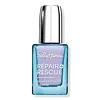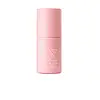What's inside
What's inside
 Key Ingredients
Key Ingredients

 Benefits
Benefits

No benefits
 Concerns
Concerns

 Ingredients Side-by-side
Ingredients Side-by-side

Ethyl Acetate
PerfumingButyl Acetate
MaskingNitrocellulose
Acrylates/Hydroxyesters Acrylates Copolymer
Acetyl Tributyl Citrate
MaskingIsopropyl Alcohol
SolventTosylamide/Epoxy Resin
N-Butyl Alcohol
PerfumingAcetylated Hydrogenated Castor Glyceride
Stearalkonium Hectorite
Gel FormingBenzophenone-1
UV AbsorberCaprylic/Capric Triglyceride
MaskingMethyl Methacrylate Crosspolymer
Dimethicone
EmollientApium Graveolens Seed Extract
AntioxidantCitric Acid
BufferingWater
Skin ConditioningAdipic Acid/Neopentyl Glycol/Trimellitic Anhydride Copolymer
Amethyst Extract
Skin ConditioningBiotin
AntiseborrhoeicTocopherol
AntioxidantLeuconostoc/Radish Root Ferment Filtrate
AntimicrobialCI 77891
Cosmetic ColorantCI 15880
Cosmetic ColorantCI 60725
Cosmetic ColorantCI 15850
Cosmetic ColorantCI 77510
Cosmetic ColorantEthyl Acetate, Butyl Acetate, Nitrocellulose, Acrylates/Hydroxyesters Acrylates Copolymer, Acetyl Tributyl Citrate, Isopropyl Alcohol, Tosylamide/Epoxy Resin, N-Butyl Alcohol, Acetylated Hydrogenated Castor Glyceride, Stearalkonium Hectorite, Benzophenone-1, Caprylic/Capric Triglyceride, Methyl Methacrylate Crosspolymer, Dimethicone, Apium Graveolens Seed Extract, Citric Acid, Water, Adipic Acid/Neopentyl Glycol/Trimellitic Anhydride Copolymer, Amethyst Extract, Biotin, Tocopherol, Leuconostoc/Radish Root Ferment Filtrate, CI 77891, CI 15880, CI 60725, CI 15850, CI 77510
Butyl Acetate
MaskingEthyl Acetate
PerfumingNitrocellulose
Adipic Acid/Neopentyl Glycol/Trimellitic Anhydride Copolymer
Acetyl Tributyl Citrate
MaskingIsopropyl Alcohol
SolventHydrated Silica
AbrasiveStearalkonium Bentonite
Gel FormingStyrene/Acrylates Copolymer
Acrylates Copolymer
Sucrose Acetate Isobutyrate
Dipropylene Glycol Dibenzoate
EmollientSilica Dimethyl Silylate
EmollientOctocrylene
UV AbsorberPolyvinyl Butyral
Di-Hema Trimethylhexyl Dicarbamate
CI 77891
Cosmetic ColorantCitric Acid
BufferingAlcohol
AntimicrobialDimethicone
EmollientTocopheryl Acetate
AntioxidantN-Butyl Alcohol
PerfumingTrimethylsiloxysilicate
EmollientCI 19140
Cosmetic ColorantCI 77499
Cosmetic ColorantWater
Skin ConditioningCI 15850
Cosmetic ColorantStearalkonium Hectorite
Gel FormingCalcium Pantothenate
Biotin
AntiseborrhoeicButyl Acetate, Ethyl Acetate, Nitrocellulose, Adipic Acid/Neopentyl Glycol/Trimellitic Anhydride Copolymer, Acetyl Tributyl Citrate, Isopropyl Alcohol, Hydrated Silica, Stearalkonium Bentonite, Styrene/Acrylates Copolymer, Acrylates Copolymer, Sucrose Acetate Isobutyrate, Dipropylene Glycol Dibenzoate, Silica Dimethyl Silylate, Octocrylene, Polyvinyl Butyral, Di-Hema Trimethylhexyl Dicarbamate, CI 77891, Citric Acid, Alcohol, Dimethicone, Tocopheryl Acetate, N-Butyl Alcohol, Trimethylsiloxysilicate, CI 19140, CI 77499, Water, CI 15850, Stearalkonium Hectorite, Calcium Pantothenate, Biotin
Ingredients Explained
These ingredients are found in both products.
Ingredients higher up in an ingredient list are typically present in a larger amount.
Acetyl Tributyl Citrate is a fragrance.
We don't have a description for Adipic Acid/Neopentyl Glycol/Trimellitic Anhydride Copolymer yet.
Biotin is a B vitamin that is naturally produced by our bodies. It is also called Vitamin H.
Our bodies use biotin in the metabolism process. It also helps our bodies use enzymes and move nutrients around. A biotin deficiency can lead to brittle hair and nails.
More research is needed on applying biotin topically. However, taking biotin orally has been shown to help nourish the skin, hair, and nails. They play a role in forming skin-hydrating fatty acids.
Biotin is water-soluble. It can be found in foods such as fish, eggs, dairy, nuts, and meat. Vitamin H stands for "haar" and "haut". These are the German words for hair and skin.
Learn more about BiotinWe don't have a description for Butyl Acetate yet.
Ci 15850 is the pigment color red. It is an azo dye and created synthetically.
Azo dyes need to be thoroughly purified before use. This allows them to be more stable and longer-lasting.
This ingredient is common in foundations, lipsticks, and blushes. This color is described as brown/orangey red.
It has many secondary names such as Red 6 and Red 7. According to a manufacturer, Red 6 usually contains aluminum.
Learn more about CI 15850Ci 77891 is a white pigment from Titanium dioxide. It is naturally found in minerals such as rutile and ilmenite.
It's main function is to add a white color to cosmetics. It can also be mixed with other colors to create different shades.
Ci 77891 is commonly found in sunscreens due to its ability to block UV rays.
Learn more about CI 77891Citric Acid is an alpha hydroxy acid (AHA) naturally found in citrus fruits like oranges, lemons, and limes.
Like other AHAs, citric acid can exfoliate skin by breaking down the bonds that hold dead skin cells together. This helps reveal smoother and brighter skin underneath.
However, this exfoliating effect only happens at high concentrations (20%) which can be hard to find in cosmetic products.
Due to this, citric acid is usually included in small amounts as a pH adjuster. This helps keep products slightly more acidic and compatible with skin's natural pH.
In skincare formulas, citric acid can:
While it can provide some skin benefits, research shows lactic acid and glycolic acid are generally more effective and less irritating exfoliants.
Most citric acid used in skincare today is made by fermenting sugars (usually from molasses). This synthetic version is identical to the natural citrus form but easier to stabilize and use in formulations.
Read more about some other popular AHA's here:
Learn more about Citric AcidDimethicone is a type of synthetic silicone created from natural materials such as quartz.
What it does:
Dimethicone comes in different viscosities:
Depending on the viscosity, dimethicone has different properties.
Ingredients lists don't always show which type is used, so we recommend reaching out to the brand if you have questions about the viscosity.
This ingredient is unlikely to cause irritation because it does not get absorbed into skin. However, people with silicone allergies should be careful about using this ingredient.
Note: Dimethicone may contribute to pilling. This is because it is not oil or water soluble, so pilling may occur when layered with products. When mixed with heavy oils in a formula, the outcome is also quite greasy.
Learn more about DimethiconeEthyl Acetate is a fragrance.
Isopropyl Alcohol is more commonly known as rubbing alcohol. It is most commonly used as a solvent, meaning it helps other ingredients dissolve.
This ingredient is an astringent alcohol. Astringent alcohols may also irritate skin as they high amounts may strip away your skin's natural oils.
Other types of astringent alcohols include:
According to the National Rosacea Society based in the US, you should be mindful of products with these alcohols in the top half of ingredients.
Any type of sanitizing product will have high amounts of alcohol to help kill bacteria and viruses.
Learn more about Isopropyl AlcoholN-Butyl Alcohol is a fragrance.
We don't have a description for Nitrocellulose yet.
Stearalkonium Hectorite is a clay-derived ingredient used to thicken a product and help create a gel-like texture.
Water. It's the most common cosmetic ingredient of all. You'll usually see it at the top of ingredient lists, meaning that it makes up the largest part of the product.
So why is it so popular? Water most often acts as a solvent - this means that it helps dissolve other ingredients into the formulation.
You'll also recognize water as that liquid we all need to stay alive. If you see this, drink a glass of water. Stay hydrated!
Learn more about Water